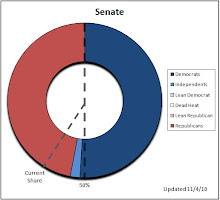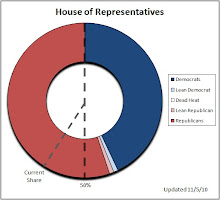Incumbent: Michael Bennet (D)
Challengers: Andrew Romanoff (D)
Jane Norton (R)
Tom Wiens (R)
Ken Buck (R)
Key Dates: Primary – August 10
PVR Projection: Lean Republican
Background
Although he is an incumbent, Michael Bennet has never participated in an election of this size. After the previous Senator, Ken Salazar, was appointed President Obama’s Secretary of the Interior, Bennet was chosen by the Governor of Colorado to hold the office until the November election. Prior to his service as Senator, Bennet had been Denver’s Superintendent of Education and Chief of Staff for the Mayor of Denver.
Democratic Challenger
Interestingly, Bennet is being challenged within his own party by former speaker of the Colorado House Andrew Romanoff. While Romanoff trails in fundraising in no small part due to his pledge not to accept any PAC money, one recent poll put him in the lead. The two candidates are meeting for their first debate tonight.
Republican Opposition
The Republican field is even messier. Three primary candidates have emerged to challenge for the Senate seat in November.
Jane Norton, former Lt. Gov. of Colorado, has gotten off to a fast start for the nomination. Still, she faces strong opposition within her own party. She has already managed to get on the bad side of former Colorado congressman Tom Tancredo who blasted Norton publicly for her “pro-amnesty rhetoric.” His criticism stems from a comment made by Norton that the country needs a “workable immigration system.” Norton’s greatest strength, perhaps, is her last name. Her husband, Tom, is a former U.S. attorney. Also in the Norton family tree is former state attorney general and Interior Secretary Gale Norton, former state Senate President Tom Norton, and University of Northern Colorado President Kay Norton.
Trying to overcome the name advantage are a pair of Republican candidates. Tom Wiens is trying to position himself as the outsider candidate in this, the year of outsiders. He has already put more than $640,000 of his own money into the campaign, claiming a need to balance the playing field. Wiens has also pledged not to serve more than two terms, if elected.
Also in the race is Weld County District Attorney Ken Buck. Buck is taking a hard-line conservative stance by supporting a balanced budget amendment, a permanent ban on earmarks, and a staunch anti-illegal immigration position. His fame comes primarily from launching a probe into the identities of thousands of undocumented workers only to have the move ruled illegal and the program shut down.
The Polls
While polls are hard to come by for individual primaries, much can be gained from polls that focus on all possible eventual matchups in the general election. The following graph demonstrates the most recent results.
The problem with the Colorado polling data is that all but one poll released since September of last year have come from Rasmussen which has simply been different from other polling agencies recently. It will be interesting to see if they turn out to be correct but much of the discrepancy comes from the estimation of likely voters in the midterm elections. Rasmussen has tended to suggest larger victories for Republicans than other polling firms.
With this caveat in mind, we can look at the above polling figures and see that Jane Norton is the clear leader. At this point, She holds a 9 point lead over Michael Bennet and an 8 point lead over Andrew Romanoff. Both Wiens and Buck still possess a lead over the Democratic opponents, but only by 2 points in all scenarios. This position is reversed, though, in the Daily Kos/Research 2000 poll from January 13th. In that poll, all contests were a statistical tie with a slight edge possibly going towards the Democratic Candidates.
Projection
The projection for this race will be a mathematical calculation based off of the recent polling averages. The chances of each candidate winning their primary is computed based off of comparing success against common opponents in the polls and averaging results. Then, the probability of success for each party in each scenario is multiplied by the probability of each scenario occurring. This will result in an overall probability for each party. This overall probability will be the projection score of the race.
A probability will be coded under the following metric:
< +5% – Dead Heat
+6 - +10% – Lean
> +10% – Solid
After calculating, the probabilities for the Colorado Senate race are as follows:
Republican Projection Score: 44%
Democratic Projection Score: 38%
This places the Colorado Senate Race as a Republican +6%, making it a Republican Lean.
http://www.kdvr.com/news/sns-ap-co--coloradosenate-debate,0,3205791.story
http://bennet.senate.gov/about/
http://www.thedenverdailynews.com/article.php?aID=7317
http://www.huffingtonpost.com/2009/09/15/jane-norton-senate-run-ta_n_286831.html
http://www.politico.com/news/stories/0210/32836.html
http://www.npr.org/blogs/politicaljunkie/2010/01/your_2010_election_calendar.html











No comments:
Post a Comment